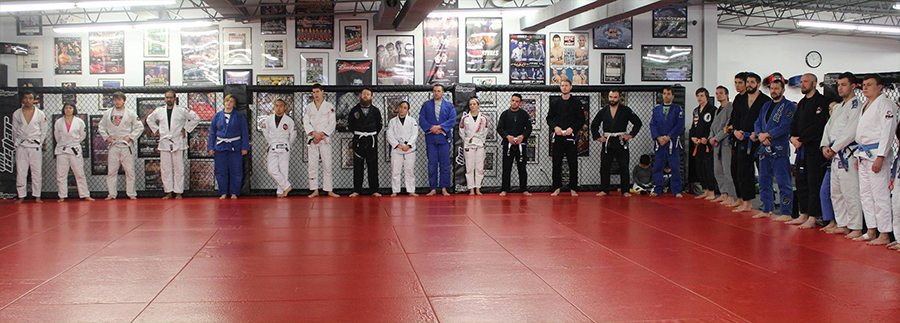What to Expect at Your First Brazilian Jiu Jitsu Class

Brazilian jiu-jitsu (BJJ) is a style of grappling developed on the principle that a smaller person can defeat a heavier, stronger opponent using leverage, timing, and submission holds. Because of its practicality in ground fighting, BJJ has become a staple in mixed martial arts as well as a popular form of self-defense. Whatever your motivation for trying BJJ may be, the first and most important step in your journey is attending your first class. Before you step on to the mat, you’ll want to know what to expect as a first-timer.
Brazilian jiu-jitsu is practiced in a uniform called a gi – loosely fitting drawstring pants and a jacket that is secured at the waist with a belt. If you don’t have your own gi yet, ask the front desk: Most schools keep spare gis for new students to borrow. Most students will also wear a rashguard or compression shirt under their gi jackets, but a regular t-shirt is perfectly acceptable at your first few classes.
BJJ utilizes a rank system of colored belts, similar to karate or judo. As a beginner, you’ll be wearing a white belt. The next rank is blue belt, followed by purple, brown, and black belt. If you’re taking a beginner or fundamentals class, you can expect most of your fellow students to be white belts as well.
When you step on to the mat, be sure to introduce yourself to the instructor (look for someone wearing a black belt, although some classes are led by brown or purple belts). Be mindful of your school’s customs; some academies with a more traditional etiquette will refer to the instructor as “Professor”, while “Coach” or just a first name might be used in a casual environment.
Every BJJ class starts with a warmup, usually a combination of calisthenics and mobility work that imitates common movements in BJJ techniques. This helps mobilize the hips, knees, back, neck, and shoulders to promote efficient movement and reduce the risk of injury. A standard BJJ warmup will include light cardio, bodyweight exercises, and sport-specific motions like hip bridges, front and back rolls, and knee walking.
Following the warmup, your instructor will demonstrate a technique such as a sweep, guard pass, takedown, or submission. As you drill the technique with a partner, your instructor will check in with each pair to offer corrections and answer any questions you might have.
Most beginner classes won’t incorporate live rolls (sparring), but some instructors like to practice situational rolls, where both people start in a specified position. Situational rolls are low to moderate-intensity, and both partners will usually reset after the objective (such as a sweep, guard pass, or scoring points) is reached. If you are attending an all-levels class and want to spar, ask your instructor for permission first.
At the end of class, you and your teammates will line up by rank, with white belts at the end of the line. Facing the instructor, all students will bow and then shake each other’s hands. If you have any additional questions about the class or something you struggled with, don’t hesitate to ask your instructor!
As you leave class, remember that it takes time, practice, and consistency to become proficient in BJJ. Be patient with yourself and stay eager to learn, and you’ll have fun along the way. Most importantly, congratulate yourself on this first step – you’ve just embarked upon one of the most enriching and rewarding journeys you’ll ever take.
Ready to get started in Brazilian jiu-jitsu? Try a class at the Cellar Gym!
Leave a Comment